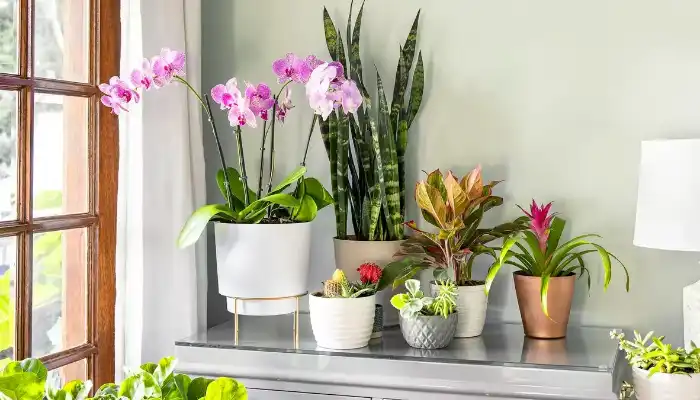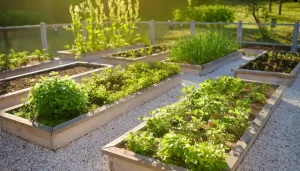Houseplants have become ubiquitous in modern home décor, their lush greenery and vibrant colors adding a touch of life to any space. But the allure of indoor plants extends far beyond aesthetics.
Scientific research has revealed a surprising array of benefits associated with incorporating plant life into our homes. From purifying the air we breathe to reducing stress and boosting productivity, indoor plants offer a wealth of advantages that enrich our home environments in unexpected ways.

The Aesthetic Appeal of Indoor Plants
The visual impact of indoor plants is undeniable. Their natural beauty instantly elevates a space, adding a touch of warmth and organic texture. The diverse range of plant life available allows for personalization according to your décor style:
- Classic Elegance: For a touch of timeless sophistication, consider snake plants (Sansevieria) with their upright architectural form or fiddle leaf figs (Ficus lyrata) with their large, glossy leaves.
- Modern Minimalism: Air plants (Tillandsia) with their whimsical, rootless form or ZZ plants (Zamioculcas zamiifolia) with their glossy, dark green foliage perfectly complement minimalist aesthetics.
- Bohemian Charm: Trailing plants like pothos (Epipremnum aureum) or spider plants (Chlorophytum comosum) with their cascading vines add a touch of whimsy and bohemian flair.
Table 1: Indoor Plants for Different Décor Styles
| Décor Style | Plant Examples | Description |
| Classic Elegance | Snake Plant (Sansevieria), Fiddle Leaf Fig (Ficus lyrata) | Upright form, large glossy leaves |
| Modern Minimalism | Air Plant (Tillandsia), ZZ Plant (Zamioculcas zamiifolia) | Rootless form, dark green foliage |
| Bohemian Charm | Pothos (Epipremnum aureum), Spider Plant (Chlorophytum comosum) | Trailing vines, cascading greenery |
Indoor Plants as Natural Air Purifiers
Indoor plants do more than just prettify our surroundings; they act as natural air purifiers. Through a process called phytoremediation, plants absorb toxins and pollutants commonly found in indoor environments, including benzene, formaldehyde, and trichloroethylene. These toxins can be emitted from furniture, cleaning products, and building materials.
Table 2: Indoor Plants for Air Purification
| Plant | Pollutants Removed |
| Snake Plant (Sansevieria) | Benzene, formaldehyde, trichloroethylene |
| Peace Lily (Spathiphyllum) | Benzene, formaldehyde, ammonia |
| Spider Plant (Chlorophytum comosum) | Benzene, formaldehyde, carbon monoxide |
| Golden Pothos (Epipremnum aureum) | Benzene, formaldehyde, xylene |
| Rubber Tree (Ficus elastica) | Benzene, formaldehyde, ammonia |
By incorporating these air-purifying plants into your home, you can create a healthier and more breathable living environment.
Stress Reduction and Mental Health Benefits
Studies have shown that indoor plants possess surprising stress-reducing properties. Interacting with plants, even simply looking at them, can evoke a sense of calmness and tranquility. Caring for plants can also promote mindfulness by encouraging us to focus on the present moment and nurturing a living thing. This focus can be a welcome respite from the constant stimulation of modern life.
Increased Productivity and Concentration: Sharper Minds in Greener Spaces
Research suggests that indoor plants can even enhance productivity and concentration. Studies have shown that students in classrooms with plants demonstrate improved focus and test scores. Similarly, office workers surrounded by greenery report feeling less fatigued and more engaged throughout the workday. Indoor plants may help to reduce mental fatigue and boost mood, leading to a more focused and productive environment.
Humidity in Harmony: The Role of Indoor Plants in Regulating Moisture Levels
Indoor plants play a crucial role in regulating humidity levels. As they transpire, or release water vapor through their leaves, they increase humidity in the surrounding air. This is particularly beneficial during dry winter months when indoor heating can create excessively dry conditions. Balanced humidity levels can help to prevent respiratory problems and improve overall comfort.
A Quieter Sanctuary: Indoor Plants as Natural Sound Absorbers
The hustle and bustle of everyday life can be overwhelming. Even within our own homes, unwanted noise pollution can disrupt our peace and concentration. Here, indoor plants offer another unexpected benefit: noise reduction.
Plants act as natural sound absorbers. Their leaves and stems absorb and dissipate sound waves, reducing the overall noise level in a room. This is particularly helpful in open floor plans or rooms with hard surfaces like tile or wood floors, which tend to amplify noise.
Choosing the Right Plants for Noise Reduction
While all plants offer some degree of sound absorption, certain varieties are particularly effective:
- Large, Leafy Plants: Plants with large, broad leaves like monstera deliciosa (Swiss cheese plant) or ficus benjamina (weeping fig) provide more surface area for sound absorption.
- Dense Foliage: Plants with dense foliage like peace lilies (Spathiphyllum) or Chinese evergreen (Aglaonema) are more effective at trapping and diffusing sound waves.
- Multiple Plants: The synergistic effect of multiple plants in a room significantly enhances noise reduction capabilities. Consider grouping plants together for maximum impact.
By strategically placing noise-absorbing plants throughout your home, you can create a quieter and more peaceful environment. This can be especially beneficial in workspaces, bedrooms, or living areas where noise can disrupt concentration or relaxation.
Versatility in Design and Space Utilization
The beauty of indoor plants lies in their versatility. They can be incorporated into various rooms and spaces to create a cohesive and stylish look:
- Living Room Oasis: A large Fiddle Leaf Fig in a stylish pot adds a touch of sophistication, while a cascading Pothos on a bookshelf creates a sense of whimsy.
- Tranquil Bedrooms: Snake Plants on nightstands add a touch of modern elegance and purify the air for a restful night’s sleep. Lavender (Lavandula angustifolia) is known for its calming properties and can be placed near the bed to promote relaxation.
- Kitchens and Bathrooms: Spider Plants thrive in humid environments and add a touch of greenery to these functional spaces. Air Plants require minimal care and can be displayed in decorative terrariums, adding a unique touch.
Table 4: Indoor Plants for Different Rooms
| Room | Plant Examples | Description |
| Living Room | Fiddle Leaf Fig, Pothos | Sophistication and whimsy |
| Bedroom | Snake Plant, Lavender | Air purification and relaxation |
| Kitchen & Bathroom | Spider Plant, Air Plant | Humidity tolerance and low maintenance |
Container Creativity: Arrangements for Every Style
Indoor plants can be displayed in a variety of containers to complement your décor:
- Modern Minimalism: Sleek ceramic pots in neutral tones create a clean and contemporary look.
- Bohemian Flair: Woven baskets or macramé plant hangers add a touch of texture and boho charm.
- Vintage Vibes: Repurposed vintage suitcases or tea tins can be transformed into unique plant pots.
Low-Maintenance Marvels: Greenery for Busy Lifestyles
Not everyone has a green thumb. The good news is there are plenty of low-maintenance indoor plants suitable for busy lifestyles or beginner gardeners:
- ZZ Plant (Zamioculcas zamiifolia): Thrives in low light and requires infrequent watering.
- Snake Plant (Sansevieria): Tolerates neglect and thrives in a variety of lighting conditions.
- Cast Iron Plant (Aspidistra elatior): Known for its near-indestructible nature and ability to survive in low light and infrequent watering.
- Spider Plant (Chlorophytum comosum): Easy to propagate and requires minimal attention.
- Air Plants (Tillandsia): Don’t require soil and can be misted occasionally for hydration.
Caring for Your Indoor Oasis: Simple Tips for Plant Success
Even low-maintenance plants require some basic care to thrive. Here are some simple tips to ensure your indoor jungle flourishes:
- Light Matters: Research the specific light requirements of each plant and place them accordingly. Most houseplants fall into three categories: low light, medium light, and bright indirect light. Avoid placing plants in direct sunlight, which can scorch leaves. Rotate your plants regularly to ensure even growth.
- Hydration Heroes: Watering is crucial, but overwatering is a common mistake. Allow the top inch of soil to dry before watering most plants. Stick your finger in the soil to check for moisture. underwatering can also stunt growth. Research the specific watering needs of each plant, as some require more or less frequent watering.
- Feeding Frenzy: While not essential, fertilizing your plants during the growing season (usually spring and summer) can give them a boost of nutrients. Use a balanced fertilizer diluted according to the package instructions. Avoid over-fertilizing, which can damage roots.
- Potentially Pot-Bound: Repot your plants every 1-2 years or when they become rootbound. Signs of a rootbound plant include roots circling the pot’s drainage holes, stunted growth, and leaves turning brown or yellow. Choose a pot that is only slightly larger than the current one to avoid overwatering.
- Pruning for Perfection: Regular pruning encourages bushier growth and removes dead or diseased leaves. Use sharp, clean pruning shears and research proper pruning techniques for each plant type.
- Pest Patrol: Keep an eye out for common houseplant pests like mealybugs or spider mites. Treat infestations promptly with insecticidal soap or neem oil. Early detection is crucial to prevent pest populations from exploding.
Conclusion
Indoor plants offer a wealth of benefits that extend far beyond aesthetics. From purifying the air we breathe to reducing stress and boosting productivity, these leafy companions enrich our home environments in surprising ways.
Whether you’re a seasoned plant parent or a curious beginner, there’s a perfect low-maintenance plant out there waiting to add a touch of life, beauty, and well-being to your home. So, embrace the greenery, care for your indoor oasis, and enjoy the numerous advantages that these botanical wonders offer.


